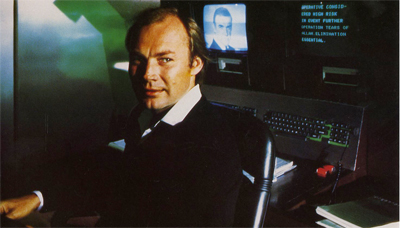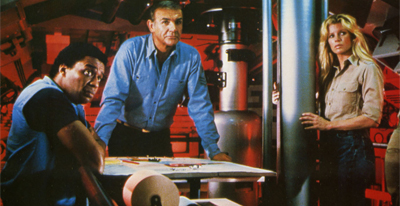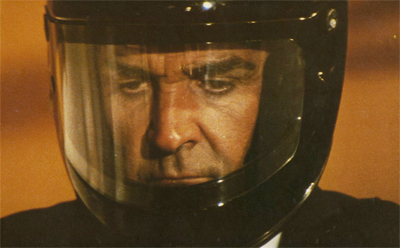Never Say Never Again has quite a lot weighing against it. Most obviously, there’s the fact that we already say this story at the height of the film franchise’s popularity, but there’s also a whole host of other issues that arise due to the attempts to distinguish this iteration of the character and story from the EON productions. There are times when the film can’t seem to decide if it is or isn’t Thunderball, just as there are times when it can’t decide if it wants to acknowledge the “other” Bond films, or ignore them completely. Despite that, there’s some good stuff on display here. The film famously opened against Octopussy, losing the box office battle. While neither is “vintage” Bond, I think that Never Say Never Again is the stronger of the two films. At least it serves as a better swan song for Sean Connery than Diamonds Are Forever.
Throughout the film, you can sense the presence of Warners’ lawyers hovering over the shoulders of director Irwin Kerschner. I imagine there were tense moments where one party or another asked “can we get away with this?” Although the film is technically a second adaptation of the novel Thunderball, emerging from a lengthy lawsuit over the story rights, it’s very clearly modelled more around the film series of the same name than it is a more literal adaptation of the novel. In fact, several elements of the film play closer to other entries in the franchise than they do to the source novel.
So there’s a rather strange feeling that the production team are trying to present a movie that looks and feels like the films starring Roger Moore, but without infringing on any copyright. So a lot of the elements are there, just rearranged so slightly. The famous “gun barrel” opening is not here. Instead, the number “007” is repeatedly printed across the screen, just in case somebody wandered into the wrong film. The random opening pre-credit sequence is here, but it’s combined with the bombastic opening theme song, which feels like the emptiest poppiest themes of the Moore era. (In fact, as soulless as All-Time High, but nowhere near as ironic as the theme to Octopussy.)
There are times when it gets a little bit too much. At one point, Bond lands on an enemy island using what can only be described as a “jet frame.” It is very clearly an attempt to evoke the memorable opening to Thunderball, without receiving a letter from EON’s attorneys. The movie never seems entirely certain if it wants to be a carbon copy, or a less-than-cheap knock-off, or if it wants to do its own sort of thing.
There’s a recurring theme that Bond and MI6 have not had a good time lately. You could read this as a commentary on the increasingly ridiculous Roger Moore films. After all, there’s a remarkable similarity between the opening to Never Say Never Again and the “official” post-Moore Bond films, The Living Daylights, with an action hero Bond demonstrating a more brutal approach than Moore was famed for, his face initially hidden from view.
The film suggests that Bond has been in retirement, that he’s been entirely absent. “Since you took over, sir, you’ve had little use for the double-0’s. I’ve spent most of my time teaching, not doing.” It’s clear that Bond was once a man of action. Perhaps there’s an attempt to court continuity with the much-loved Sean Connery films, as if to suggest that the “real” Bond has been out of action while his impersonator has been running around dressing like a clown and flying parachutes with the Union flag.
As with Thunderball, the movie opens with Bond being sent to a health spa, but there might be a none-too-subtle hidden message here. Perhaps Never Say Never Again is admitting that it plans to rehabilitate Bond by literally doing so. Being honest, I’d almost admire such a brazen statement, given how the movie indulges in so many of the tropes of the earlier films. If Never Say Never Again had the guts to state more forcefully that it was an attempt to offer an alternative to the camp Roger Moore films, I’d almost respect it.
The problem is that – if you interpret those moments as a jab at Moore’s tenure – the film seems weirdly bipolar. If those scenes seem to suggest Bond is finally returning to screen, then why does the movie include so many over-the-top touches we associate with Moore. There’s the ridiculously over-the-top and highly improbable video-game that would not seem out of place in a Moore film, and the early fight with the goon in the clinic is Sean Connery doing his best Moore impression.
That’s not to suggest it’s an inherently bad scene – that bit with the fight on the telly is quite clever and the urine gag is at least foreshadowed – but that it’s the kind of ridiculous stuff you’d see in Octopussy. If you are going to assert your legitimacy by claiming to “return”Bond to his roots, don’t bask in the same tropes as the films currently being released. The Rowan Atkinson stuff in particular seems like the kind of nonsense Moore does so well.
The film is also let down by some cheesy special effects. While Moore’s films might not have had the best green screen sequences (check out his “skiing” in The Spy Who Loved Me), none looked quite as dodgy as Bond and Domino jumping off the edge of the fortress on a horse. There’s also some woefully dodgy stock footage of things like a submarine going underwater. Even the underwater sequences, which had an element of novelty in Thunderball, feel sort of passé here. (To be honest, I thought those sequences were over-indulgent in the original film, but they were much more impressive than anything barring the shark chase here.)
And yet, despite all that, there’s a lot to like here – even if the two accounts don’t necessarily settle up in the end. Sean Connery is much more convincing here than he was in Diamonds Are Forever. I’m fonder of his work there than most, but he was very clearly on auto-pilot. Here, Connery actually seems to care. While there’s grey in his hair, he looks a bit fitter and more in shape, and he gets the most out of his silky one-liners. Moore was the master at debonair one-liners, but Connery does a wonderful job too. “How reckless of me!” Fatima blushes. “I made you all wet.” Bond smiles. “Yes, but my martini’s still dry.”
Ignoring the silly video game stuff, I like the portrayal of a radically changing MI6, in contrast to the increasingly stuffy bureaucracy in the Moore films. GoldenEye would give the original series a dramatic shake-up a few years after it was necessary, but Never Say Never Again seems to make an endearingly genuine effort to present a markedly different office atmosphere around Bond. I love the notion of Q working in a grotty metal shop complaining about his budget, “Yeah, I wish I had a new contract. They’ve slashed my budget. You can’t get the spare parts. And when you can, some strike stops delivery.”
I also like the idea of a touchy-feely M in contrast to a decidedly old-fashioned James Bond. Again, GoldenEye would provide a much more effective variation on the same thing, with a female M managing “a sexist misogynist dinosaur”, but it’s funny to see a New Age M. Like Judi Dench, Edward Fox has little time for his more brutal agents. He confesses, “I hold your methods in much less regard than my illustrious predecessor did.” (Another attempt to anchor the series to the EON productions.)
Edward Fox is charming, even if his health philosophy feels a little bit too “eighties” at times. “Too many free radicals, that’s your problem,” he explains to Bond. “Toxins that destroy the body and brain. Caused by eating too much red meat and white bread, and too many dry martinis.” It’s a shame that the script plays him for laughs, rather than exploring the clash of cultures that would exist between a younger version of M and an older 007.
Speaking of Edward Fox, the casting is great. Okay, maybe discounting Rowan Atkinson. Kim Bassinger is no better or worse than most of the Moore-era girls. Bernie Casey is the best on-screen Felix Leiter, although hopefully Jeffrey Wright gets a chance to develop the role a bit more. But the villains are fantastic. The original Thunderball gave us the wonderful Fiona, one of the more interesting female characters of the Connery era. Here, Fatima seems like an attempt to take that originally feminist villain – one who Bond couldn’t seduce to the side of righteousness – and update her for the eighties.
A lot of Fatima’s characterisation works very well. Barbara Carrera his having the time of her life in the role. While her “gimmick” feels a little bit too much like a Moore-era baddie, the notion of a snake fits the character’s gender fixation – Freud would certainly make a lot of it. Plus, her attempts to castrate Sean Connery are even more explicit than those made by the title villain in Goldfinger. “Spread your legs. Good. Very good. You’re quite a man, Mr James Bond. But I am a superior woman. Guess where you get the first one.” She’s hardly subtle, but a misandrist villain was still a nice and novel concept at this point.
Never Say Never Againwas still over a decade away from the series’ first true female baddie, and Fatima is treated like a henchwoman – just like Mayday or Fiona or any of the others in the franchise’s history. Still, there’s something quite refreshing about the thrill she takes in violence, a deadly female character allowed the sadism that seems to come naturally to the male villains Bond regularly tackles. Her interactions with Largo paint her as almost an equal, and it’s hard to imagine another hench-person getting away with the cutting remarks she makes.
“I think you have lost her,” Fatima teases the villain. Largo responds, more playfully than irately, “Do you imagine that I could lose a woman to an underpaid British agent? Ja?” Clearly not feeling that she’s got her point across, Fatima takes the time to mock Largo’s gratuitous foreign language and accent, responding, “Ja. And I warn you, if he’s not executed at once, he’ll have your Domino turned over.” Given how possessive Largo is of Domino, it says quite a bit that Fatima is allowed to speak of her like that.
All this is, of course, undone in her final scene when Fatima becomes a nervous wreck at the notion that she was not the best woman James Bond ever slept with. It feels like the type of shallow parody of feminism that Fleming’s books might trade in, with Fatima reduced to the butt of joke by her own insecurity about her performance in bed. In fact, she has Bond dead to rights, but it literally defeated when she forces Bond to write a note stating that she is the best woman he ever slept with. It takes an interesting character and just undermines her in the most shallow and ridiculous fashion possible. It’s a shame, because Fatima is pretty great up until that point.
Klaus Maria Brandauer actually makes a rather magnificent Bond villain, and perhaps the most appealing aspect of the entire film, once you get past the novelty of seeing Sean Connery giving a damn about playing James Bond again. I know that Emilio Largo is generally considered one of the iconic film villains, informing the characteristics of “Number Two” in Austin Powers among others, but I never truly warmed to Adolfo Celi in the role.
Brandauer plays Maximillian Largo is even more creepily paternalistic. Celi’s Largo had the same sort of possessive thing going on with his version of Domino, but Brandauer ramps it up several notches with his two-way mirror and his fiendish plan to lock her away on an island. “How do you like… your new home, my princess?” He might as well laugh as he taunts “my pretty!” over and over again. I can’t help but think that Brandauer’s deliciously sleazy Eurotrash villain informed the portrayal of Dominic Greene in Quantum of Solace years later.
When Bond arrives on the yacht, he finds a henchman waiting for him. “Mr. Largo’s been expecting you.” Largo is quite proud of his plans as he boasts to Bond, because he clearly sees Bond as no threat to him – perhaps the most convincingly dismissive villain since Julius No all those years ago. Bond has to kiss Domino in order to catch Largo off-guard. He explains, “I’m going to kiss you. I want you to respond as if you liked it. I’m doing this for two very good reasons. One, because I’m hoping to provoke a reaction.” He certainly does that.
Largo is even fatherly to the other characters, including Dr. Kovacs, who is clearly nervous when speaking to Blofeld. Once Kovacs has said his piece, Largo seems almost cheerful as he waves him off. “Go ahead! Go ahead!” It’s a fascinating portrayal, and one that feels a lot more like a classic. Connery-era villain, the bad guy who believes himself in complete control of his surroundings and circumstances.
I’ll also admit that Brandauer captures the character’s creepy sadism remarkably well. The construction of a video game that causes physical pain is easily one of the most ridiculously absurd set pieces in any Bond film ever. And that’s before the guy donating to orphans starts showing it off at his gala charity ball. However, Brandauer palys the scene well enough to stop it descending into complete camp, providing us with a villain who seems to get off on his own pain as much as his adversary’s.
After all, Largo is one of the few villains who doesn’t cheat. He plays remarkably fair with Bond, despite the rather obvious temptation to exploit the system. “Unlike armchair generals, we will share the pain of our soldiers, in the form of electric shocks. One last point: if you let go of the controls, you forfeit the game. As you were unaware of this, we will begin again.”He lets Bond start from scratch no less than three times, and plays fair with him each time. It seems that, for Largo, the pain is more important than the victory – something that distinguishes him from most of Bond’s adversaries.
Never Say Never Again is ultimately far from satisfying. There’s a sense we’ve seen this all before. I know why it had to be Thunderball, but if one of Connery’s first five films deserved a remake it was You Only Live Twice. (And I say that as a fan of both the film, and the book, but it’s one adaptation that would have felt sufficiently different from the film to merit a second adaptation.) Never Say Never Again can’t decide if it’s trying to emulate or to better its EON counterparts, and the result is a bit of a mess.
Still, there’s a lot of interest here. And while it’s damning with the faintest of praise, it’s a far better Bond film than either Octopussy or Diamonds Are Forever.
Filed under: Non-Review Reviews | Tagged: bond, film, GoldenEye, james bond, James Bond in film, Movie, Never Say Never Again, non-review review, Octopussy, review, Roger Moore, sean connery, Spy Who Loved Me, thunderball |

































More than any other Bond, Connery is most associated with a specific era: the glamorous jet-set 1960s. It’s always so jarring watching this film and seeing him in the grungy 1980s.
That is fair, I think. I am very curious if the next reboot of the Bond franchise will be a period piece.